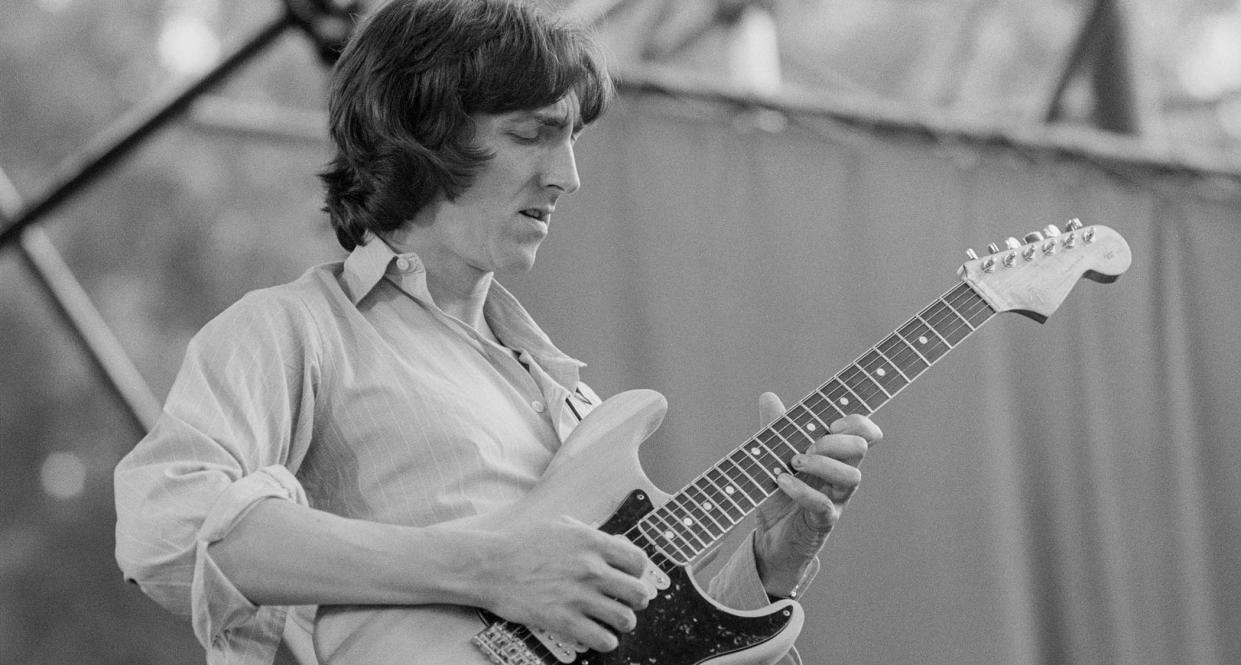How Allan Holdsworth blew the minds of Eddie Van Halen, Steve Vai and a generation of guitar heroes

- Oops!Something went wrong.Please try again later.
- Oops!Something went wrong.Please try again later.
Allan Holdsworth was born in Bradford, Yorkshire in 1946. An early member of bands like Soft Machine and UK, in the ’80s he released a slew of masterpiece albums that changed the landscape of jazz and fusion guitar. His style was so influential that his name is mentioned by the likes of Van Halen, Satriani, and Vai as one of the greatest guitarists to have walked the planet.
Allan had a linear melodic style that defied tradition. He also possessed a unique self-taught perception of theory and and the guitar fretboard, quite removed from the more formulated structures we are used to today.
His approach was idiosyncratic and his music sounds almost alien. Although he would use jazz-inspired ‘outside’ harmony, he would also often use typical scales and modes, albeit heavily disguised.
Our first three examples use the Lydian mode, the minor pentatonic and the Dorian mode, with no passing notes. Allan’s use of legato, string skipping, and his skill at finding patterns within scales gives the music its otherworldly dimension.
Add to this his smooth legato technique and large hands and the result is something that enables wide stretches and a flow of notes not naturally available to most players. With practice we can achieve this sound by making each note the same volume and blending in softer picked notes to disguise string changes and create seamless links between notes across the entire fretboard.
Allan enjoyed finding symmetry and patterns that could be applied to different strings. Example 4 is based in the half-whole diminished scale, constructed in half and whole tones to create an eight-note pattern. It offers a great deal of scope for creativity and has many elements to explore, which of course Allan did to its limits.
Example 5 is built around another symmetrical scale, a repeating ‘tone-semitone-semitone’ sequence. Start from any root note and repeat this pattern and the nine-note result is: 1-2-b3-3-#4-5-b6-b7-7. The pattern repeats every major 3rd, which lends an augmented flavour to the proceedings.
There is also a blend of Lydian and Aeolian modes for an interesting simultaneous major and minor sound. In his 1992 instructional video, Allan simply refers to this as the symmetrical scale, but more specifically we can identify it as ‘Messiaen mode 3’.
The name originates from French 20th century composer Olivier Messiaen, who created a list of seven ‘modes of limited transposition’, which are all symmetrical scales. The list includes the familiar whole-tone and diminished scales, as well as various lesser-known ones including this Allan Holdsworth favourite.
Play each example slowly and accurately at first and gradually speed up in small increments as your muscle memory and finger dexterity improves.
Get the tone
Amp Settings: Gain 7, Bass 4, Middle 7, Treble 4, Reverb 1
Allan played Steinberger, Bill DeLap, and a Kiesel signature guitar with a single bridge humbucker pickup. He also also used the Yamaha UD-stomp pedal and had a Rockett Pedals signature overdrive pedal. The Holdsworth tone is very smooth and even, with boosted mids and not much presence or treble which created his mellow sound. Just add reverb.
Example 1. Ionian arpeggio lick
This lick is based entirely within D Ionian (D-E-F#-G-A-B-C#), and uses arpeggios, wide stretches and string skips for an Allan-style phrase. Hold the whammy bar loosely in your palm throughout and use it to add vibrato and scoop into the notes indicated for a synth-like pitch bend.
Example 2. Wide-stretch Dorian lick
Based in E Dorian (E-F#-G-A-B-C#-D), this lick uses string skipping and wide stretches to repeat the same note on different strings. The latter half of the lick uses a wide stretch shape on each string using the 12th, 14th and 19th frets. If this is too much of a finger stretch, feel free to tap the 19th-fret notes.
Example 3. Stretchy sextuplet lick
Continuing the wide stretch theme, this lick begins with B minor pentatonic (B-D-E-F#-A) played with three notes per string, then extends to B Dorian by adding C# and G# in the second half.
Keep the sextuplet phrasing even by targeting with the particular finger that lands on each downbeat. This is made more challenging with a five-note melodic pattern embedded within the six-note feel.
Example 4. Half-whole diminished lick
This lick uses D half-whole diminished which contains eight notes (D-Eb-F-F#-G#-A-B-C). There are various symmetrical patterns within the scale that offer many Holdsworthian options for accessing movable shapes, transferrable to different strings. Use this lick to generate your own ideas (It Bites’ Francis Dunnery did).
Example 5. Messiaen nine-note scale lick
This lick is based in Messiaen’s 3rd mode from an A root (A-B-C-C#-D#-E-F-G-G#). Focus on picking at the same volume as your legato notes in order for the notes to flow together in a liquid like fashion. As the phrasing switches between 16th-notes and sextuplets be sure not to speed up in tempo.

